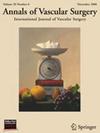The Efficacy of Dual-layer Stent Compared to Single-layer Stent in Carotid Revascularization: A Systematic Review and Meta-analysis
IF 1.4
4区 医学
Q3 PERIPHERAL VASCULAR DISEASE
引用次数: 0
Abstract
Background
Prior studies have demonstrated the dual-layer stent (DLS) was associated with encouraging results in carotid revascularization. This meta-analysis aimed to study the comparative efficacy between DLS and single-layer stent (SLS).
Methods
The studies were retrieved from PubMed, Embase, and Scopus up to June 2023. The methodological evaluation was performed using the corresponding scale. Pooled analysis was conducted using R Studio to calculate the effects, including odds ratio (OR) and mean difference (MD). Heterogeneity among results was assessed using the I2 statistic. Sensitivity analysis and subanalysis were also performed.
Results
In this meta-analysis, nine articles comprising 1,127 patients who underwent carotid stenting (606 with DLS) were studied. No significant difference between DLS and SLS was found in stroke (at 30 days DLS: 4/555 vs. SLS: 11/496; OR 0.38, 95% confidence interval [CI] 0.14–1.03; at 12 months DLS: 1/249 vs. SLS: 4/152; OR 0.21, 95% CI 0.03–1.36), death (at 30 days DLS: 3/526 vs. SLS: 0/467; OR 0.80, 95% CI 0.20–3.11; at 12 months DLS: 5/249 vs. SLS: 3/152; OR 1.12, 95% CI 0.25–5.03), stroke/death (at 30 days DLS: 6/526 vs. SLS: 11/467; OR 0.43, 95% CI 0.16–1.17; at 12 months DLS: 6/249 vs. SLS: 7/152; OR 0.52, 95% CI 0.17–1.61), new lesions (DLS: 56/202 vs. SLS: 96/254; OR 0.62, 95% CI 0.28–1.40), lesion count (MD = −0.24, 95% CI -0.82–0.34), lesion diameter (MD = −0.03, 95% CI -1.21–1.15), in-stent restenosis (ISR; DLS: 5/204 vs. SLS: 8/190; OR 0.61, 95% CI 0.21–0.74) and acute thrombosis (DLS: 4/146 vs. SLS: 1/122; OR 2.03, 95% CI 0.31–13.26). Subgroup analysis indicated that CGuard and Casper had shown similar efficacy in preventing stroke, death, and new brain lesions.
Conclusion
DLS has shown comparable prognoses to the first-generation stent concerning stroke, stroke/death, new magnetic resonance imaging lesion incidence, lesion count, lesion diameter, ISR and acute thrombosis. Further randomized trials are warranted to demonstrate whether patients with high-risk carotid plaques can benefit significantly from DLS.
求助全文
约1分钟内获得全文
求助全文
来源期刊
CiteScore
3.00
自引率
13.30%
发文量
603
审稿时长
50 days
期刊介绍:
Annals of Vascular Surgery, published eight times a year, invites original manuscripts reporting clinical and experimental work in vascular surgery for peer review. Articles may be submitted for the following sections of the journal:
Clinical Research (reports of clinical series, new drug or medical device trials)
Basic Science Research (new investigations, experimental work)
Case Reports (reports on a limited series of patients)
General Reviews (scholarly review of the existing literature on a relevant topic)
Developments in Endovascular and Endoscopic Surgery
Selected Techniques (technical maneuvers)
Historical Notes (interesting vignettes from the early days of vascular surgery)
Editorials/Correspondence

 求助内容:
求助内容: 应助结果提醒方式:
应助结果提醒方式:


